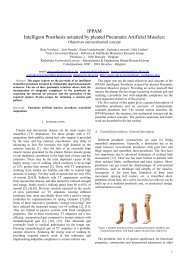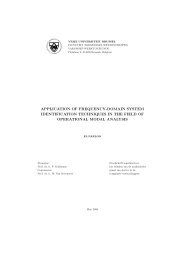VRIJE UNIVERSITEIT BRUSSEL Acoustics - the Dept. of ...
VRIJE UNIVERSITEIT BRUSSEL Acoustics - the Dept. of ...
VRIJE UNIVERSITEIT BRUSSEL Acoustics - the Dept. of ...
You also want an ePaper? Increase the reach of your titles
YUMPU automatically turns print PDFs into web optimized ePapers that Google loves.
6.3. TACKLING NOISE TRANSMISSION 113at <strong>the</strong> end <strong>of</strong> <strong>the</strong> system due to changes in <strong>the</strong> cross-sectional area or bychanging <strong>the</strong> rigidity <strong>of</strong> <strong>the</strong> wall by transition <strong>of</strong> pipes to tubes. Absorption<strong>of</strong> Hydrodynamic noise is provided by accumulators. The design rules for<strong>the</strong> control <strong>of</strong> liquid-born noise are :1. Use a combination <strong>of</strong> pipes and tubes.2. Use dampers.6.3.3 Structure-borne noise transmissionThe transmission <strong>of</strong> structure-borne noise from sources to radiating surfacescan be influenced by changing <strong>the</strong> mass, stiffness and damping <strong>of</strong> <strong>the</strong> structure.The selected strategy depends on a number <strong>of</strong> factors :Is an increase <strong>of</strong> weight possible or not? If so, an increase <strong>of</strong> mass near<strong>the</strong> region <strong>of</strong> excitation will be efficient.Force excitation or speed excitation? In case <strong>of</strong> force excitation, addingimpedance (mass) will be effective, in case <strong>of</strong> speed excitation, addingmass has no sense (in <strong>the</strong> latter case, <strong>the</strong> source may be isolated).Narrow-band or broadband excitation? For a narrow-band excitation,it is advisable to redistribute <strong>the</strong> stiffness or mass <strong>of</strong> <strong>the</strong> system (inorder to shift <strong>the</strong> resonance frequencies). The addition <strong>of</strong> damping canalso be effective. This has no sense for broadband excitation and abroadband reduction <strong>of</strong> <strong>the</strong> transmission needs to be obtained.Excitation at low frequencies, intermediate frequencies or high frequencies(quasi-static, resonance or multi-resonance response respectively)?At low frequencies, vibration isolation is <strong>the</strong> only possible solution.Panels with free edges radiate, in general, less noise than clamped panels(see Figure 6.15). In <strong>the</strong> middle frequency region, a number <strong>of</strong>solutions can be chosen :– Adding mass at <strong>the</strong> excitation point (see Figure 6.16).– Increasing <strong>the</strong> structural damping– Isolate <strong>the</strong> source (e.g. see Figure 6.18).– Reflection at discontinuities (see Figure 6.17).In <strong>the</strong> high frequency region, <strong>the</strong> following measures can be effective :– Increasing <strong>the</strong> mass or stiffness <strong>of</strong> <strong>the</strong> excitation region.
















